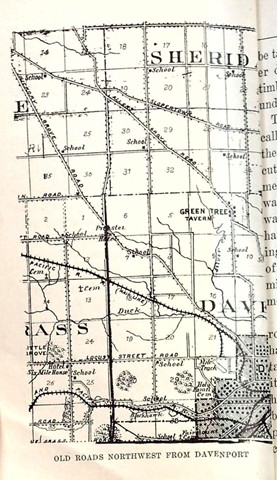One road which could never have been named in pioneer days is now called in some counties through which it passes the “telegraph road”. Many roads have telephone lines along them, but only one main road across Iowa has a telegraph line along its entire length. Perhaps some who will read this live on the road along which the Transcontinental Telegraph Line is constructed.
It does not seem right to change the old names of the roads or streets to something fanciful, just to suit people who have no interest in preserving the early history. Neither men and women nor boys and girls should wish to destroy that which connects the present with the past of our State. Sometime people may be willing to give attention to these interesting places and will take time to mark them. It is such roads as these Territorial or connection roads that run through farms at an angle, and along which one does not often come to square corners. After the farm houses were built on these, people objected to change, so that now the general direction remains as at the beginning.
The United States Government sometimes wanted a road over which soldiers could travel in the Indian country; or in the new settled parts where there might be danger to white men. Or, perhaps, soldiers were needed to protect the Indian lands before the white men were allowed to come upon them. Very often the white men were driven out by the soldiers from the places they had settled because the land still belonged to the Indians.
The roads built especially for troops to pass over were called military roads. One of these was laid out about 1839 in Iowa, from Dubuque through the counties of Jones, Linn, Johnson, Washington, Henry and Van Buren to the Missouri line. Bridges were built at some places on the road by soldiers and, of course, it became a very important road for all persons. Someone has said that this road formed the main street of Monticello, in Jones County. It crossed the Cedar River at a place called Ivanhoe below Cedar Rapids, and the Iowa River just below Iowa City. Such large streams were crossed at fords or ferries.
Over this route in 1850, the daily stage came from Dubuque. At Monticello there was a station to change horses and drivers; and not far south of that place one might have stopped at the Buckhorn Tavern, which would have been easily known by the deer horns on the archway over the gate. But almost any house on a main traveled road was a tavern to travelers, for no hungry or weary person was turned away, whether or not he had money. On the map of Dubuque County the one road leading from the city directly toward the southwest is called the Dubuque and Cascade military road. This is probably the original route of the United States government road. There were other military roads, but his was the longest one in the Territory of Iowa.






